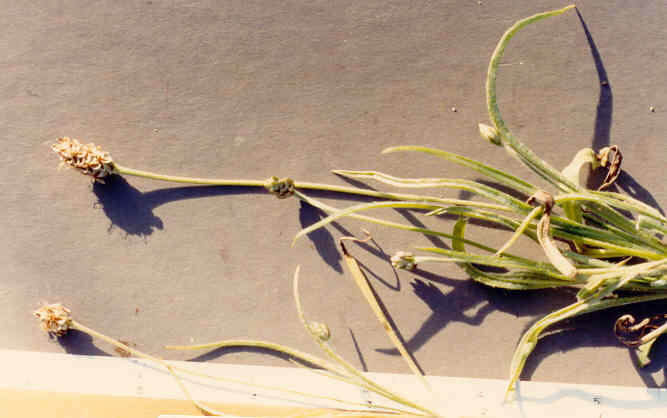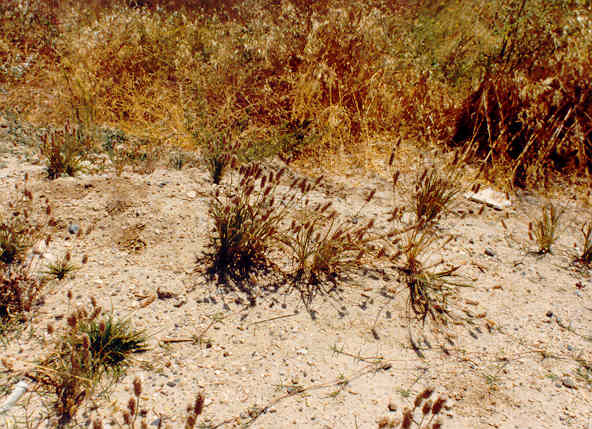
Plantago erecta E. Morris
=P. hookeriana var. californica
 |
Plantago erecta E. Morris=P. hookeriana var. californica
Plantaginaceae (Plantain Family)NativeCalif. Dwarf Plantain |
February Photo
Plant Characteristics:
Villous annual; lvs. filiform to linear-lanceolate, entire or with small remote
denticulations, 3-12 cm. long; scapes 5-25 cm. tall, erect to arcuate-ascending;
spikes capitate to short-cylindric, 5-25 mm. long, dense; bracts ovate, broad at
base, scarious-margined at least half their length, not exceeding calyx, half as
long as sepals; sepals scarious-margined, oblong, 3 mm. long, villous;
corolla-lobes spreading, 1-2 mm. long; caps. ellipsoid, ca. 3 mm. high, seeds 2,
dull brown, 2-2.5 mm. long, finely pitted.
Habitat:
Common, dry open places, below 2500 ft.; Coastal Sage Scrub, V.
Grassland, Chaparral, etc.; cismontane Calif.; to L. Calif., Ore., Channel Ids.
March-May.
Name:
Latin, planta, footprint.
(Munz, Flora So. Calif. 633).
Latin, erectus, erect.
(Jaeger 95). The old species name, hookeriana,
named in honor of either William Jackson Hooker,
1785-1865, or his son, William J. Hooker,
1817-1911, both English botanists. (Jaeger
310).
General:
Occasional in the study area. Common
in the Santa Ana Heights Flats. Photographed
on the west side of the Delhi Ditch and near the top of the bluff between Big
Canyon and the north end of Eastbluff. (my
comments). Several of the draws on the westerly
side of the bay have been graded by the Irvine Co. and these now have large
numbers of this species when there is enough moisture to support their growth.
(my comments). One of the general characters of the
family is that the seeds have a mucilaginous coat, hence they are of some value
as a laxative when soaked in water and eaten raw.
(Kirk 65).
Why should nutrient additions from sources such as fertilizer be
considered habitat degradation? Plants
adapted to stressful or low-fertility environments may be susceptible to changes
in nutrient availability. For
example, in Californian serpentine grassland, where soils formed from serpentine
rock are naturally low in nitrogen and phosphorus, application of fertilizer
increases non-native annual grasses such as Bromus
mollis and Lolium multiflorum and
decreases native annuals such as Plantago
erecta and Lasthenia californica.
Weedy species, both native and non-native, grow vigorously with
additional nutrients and out compete natives adapted to poor soils.
(Huenneke, Laura F. "Managing
Land To Protect Rare Plant Populations"
Fremontia, A Journal of the Native Plant Society. July 1988 p.
3-8). About
250 species and 3 genera, of which the largest and most cosmopolitan is Plantago.
(Munz, Flora So. Calif. 633).
P. hookeriana var. californica
misapplied. (Hickman, Ed. 1347).
Text Ref:
Abrams Vol. IV 21; Hickman, Ed. 820; Munz, Calif.
Flora 408; Munz, Flora So.
Calif. 633; Roberts 32.
Photo Ref:
June 3 83 # 22; Feb 1 85 # 21.
Identity: by R. De Ruff, confirmed by F. Roberts.
Computer Ref: Plant Data 243.
Have plant specimen.
Last edit 3/22/03.
 |
June Photo